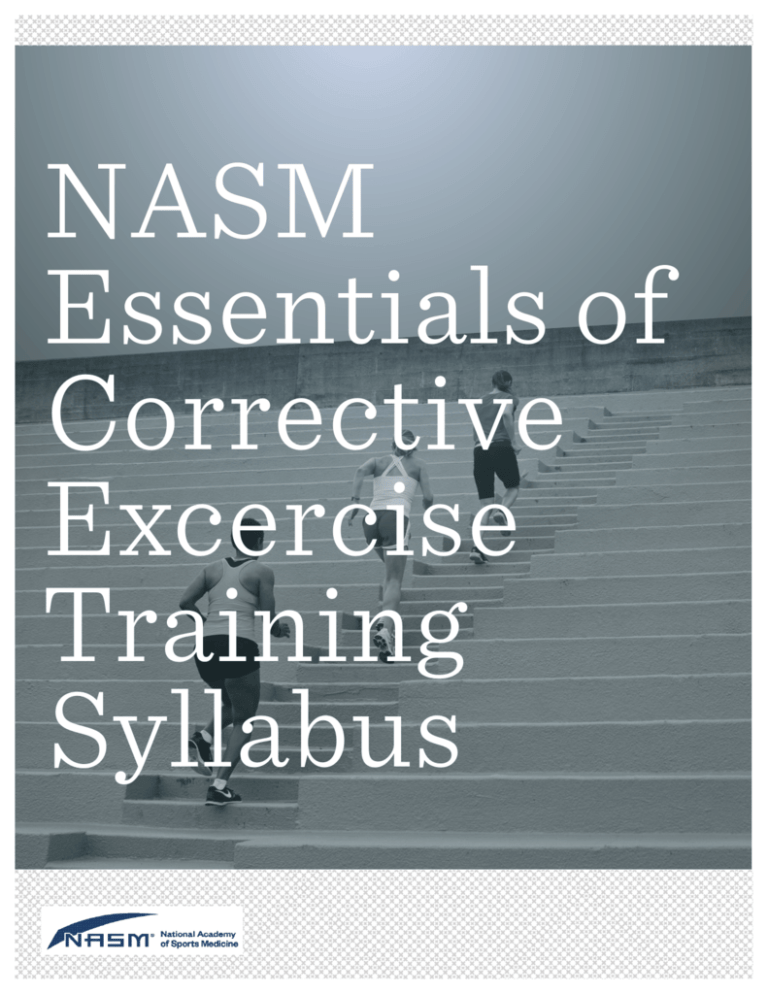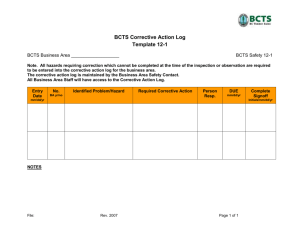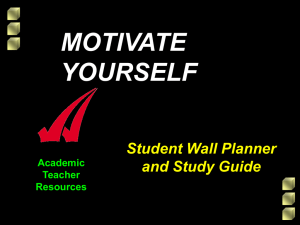
NASM
Essentials of
Corrective
Excercise
Training
Syllabus
1
NASM CES SYLLABUS
SKILLS FOR SUCCESS: TIME MANAGEMENT AND ACTIVE READING
Congratulations on enrolling in NASM’s Corrective
Excercise course! Now what should you do?
First, realize you need to do a lot of work over the next
few months to prepare for the certification exam.
Only you can ensure success in achieving your goal of
becoming a corrective exercise specialist.
You can own the responsibility of your success by
thinking about your motivation for pursuing this
career path. How did you become interested in
corrective exercise? What experiences moved you in
this direction? Keep those motivations in mind as you
commit to the work necessary to achieve your goal.
Getting there is probably going to be harder than you
expect so you must be persistent. Remember, you chose
this career so be open to doing the work necessary of
becoming a corrective exercise specialist.
it is better to spread out your weekly study time over
several days rather than trying to cram it all on one day.
Give yourself a day each week away from your studies.
This helps keep you focused and energized about your
It is time to get organized. We know from experience
that successful students spend about 40–50 hours
working through the course materials in preparation
for the exam. Think about when you want to take the
exam to determine how many hours per week you need
to commit to studying. This will likely translate to
approximately 4–6 hours per week. Take a look at your
schedule. What do you do on a typical day? How about
in a typical week? Start thinking about how you will fit
study time into your days. Create a weekly schedule and
block out your current time commitments for work,
family, and any other activities you engage in on a regular
basis. Hopefully you see available pockets of time during
the week that you can devote to your studies. If not,
consider changes you are willing to make to ensure you
meet that weekly time commitment. Keep in mind that
course work.
Copyright © 2012
National Academy of Sports Medicine
Printed in the United States of America
Distributed by:
National Academy of Sports Medicine
1750 E. Northrop Blvd. Suite 200
Chandler, AZ 85286
800.460.NASM
Facsimile: 480.656.3276
http: //www.nasm.org
All rights reserved. Except for use in a review, the reproduction or utilization of
this work in any form or any electronic, mechanical or other means, now known or
hereafter invented, including xerography, photocopying and recording, and in any
information-retrieval system is forbidden without the written permission of the
National Academy of Sports Medicine.
Create a study space for yourself. This space should
be somewhere quiet, away from activity where you
can concentrate and establish your study routine.
Gather any supplies you think you need before sitting
down and keep them within reach. Think about what
might distract you as you work and be proactive to
limit those distractions: silence the ringer on your
cell phone; if working on your computer, close any
Internet applications such as e-mail, social media
sites, or games; turn-off the TV or other devices unless
background noise or music help you concentrate. This
is your study space and time spent here is devoted to
your course work.
2
NASM CES SYLLABUS
So, you have your study schedule, your study space is
set-up, and you are ready to start reading. How are you
going to read the material? Many students think they
can read something once and that is enough for them to
understand and remember the content. Unfortunately,
that just does not work very well for most of us. The
best approach is to use active reading which consists
of techniques that will help you stay focused and
attentive to details. There are four steps in the active
reading process: previewing, marking, reading with
concentration, and reviewing.
Previewing gives you the big picture of what you are
about to read and connects you with what you might
already know about the topic. Skim the introductory
paragraph(s) and the summary. Now, skim through the
reading; note the topic headings and subheadings, and
the length of the chapter. Use this information to decide
how much material you can cover in this first session.
Over time you will find your concentration builds and
you can plan your study sessions accordingly.
Marking can mean anything from highlighting text
to making notes in the text margins. There are two
guidelines to follow in this step: Read before you mark
and Think before you mark. Read through a section and
think about what you read. If you like to highlight or
make notes, do that after you read the section. This will
help you better decide what is important. Alternatives
to highlighting are creating outlines, visual maps,
flashcards, or taking notes. Any of these tools will be
very helpful for reviewing the material later.
Reading with concentration simply means you
want to create the best possible situation for you to
concentrate on what you read. Consider the following
to help you concentrate better: minimize distractions,
read in blocks of time with short breaks in between, set
goals for your study period, take a short exercise break to
refresh if you feel sleepy or have trouble concentrating,
write down questions, reread confusing sections, and
consult the glossary for unfamiliar terminology.
Reviewing is the final step and is just as it sounds —
making time to review what you read. This should
be done regularly in your study time and is easier if
you made notes, cards, maps, or outlines earlier in
the reading process. Look at the questions you wrote
down and see if you know the answers. In reviewing,
you might use any techniques you know to help you
remember and connect all the new information you are
learning. You want to understand not only the factual
information but also why those facts are relevant to
your future as a corrective exercise specialist.
Remember, your success is entirely up to you so
take control; own it. Think about your motivations
for pursuing this program and the goals you want
to achieve. Organize your time and your space for
maximum benefit. Work through the corrective
exercise material in a step-by-step manner with
attention and persistence. Look for ways to apply what
you learn in your life. Most of all enjoy this learning
experience for the opportunities it may open for you
and for your own intellectual curiosity. Good luck!
Success plan
The study planner below has been created as a
suggested guide to help you along your journey. The
study planner follows a 65-day schedule, but feel free to
move at a pace that is right for you.
Study Planner
By following the study planner, you will stay focused
on key areas and make studying simple. The study
planner has been carefully organized according to the
subject domains on which you will be tested during
the corrective exercise exam. Keep in mind the study
planner does skip chapters 7 and 8 because goniometric
assessment and manual muscle testing are topics
outside the scope of practice for personal trainers.
These topics are included in the textbook and only
intended for licensed professionals (certified athletic
trainers, physical therapists, chiropractors) who are
enrolled in the CES. Topics from these two chapters
will not be on your exam. In addition, the CES exam
does not include questions referencing neuromuscular
stretching (found in chapter 10) and positional
isometrics (found in chapter 11) for the same reason.
3
NASM CES SYLLABUS
65-DAY STUDY PLANNER
STUDY
DAY
COMPLETION
DATE
CHAPTER
ASSIGNMENT
Introduction to Corrective Exercize
Day 1
1 – The Rationale for Corrective Exercise
⦁⦁
Become familiar with study materials and
online format
⦁⦁
Watch module 1 online presentations
(7 min 47 sec)
⦁⦁
Read Chapter 1
⦁⦁
Complete Chapter 1 exercises in the
study guide
1 – The Rationale for Corrective Exercise
⦁⦁
Review online content and Chapter 1
Day 4
2 – Introduction to Human Movement
Science
⦁⦁
Watch module 2 online presentations
(29 min 37 sec)
Day 5
2 – Introduction to Human Movement
Science
⦁⦁
Read Chapter 2
⦁⦁
Complete Chapter 2 exercises in the
study guide
Day 6
2 – Introduction to Human Movement
Science
⦁⦁
Complete module 2 online activities
Day 7
2 – Introduction to Human Movement
Science
⦁⦁
Review module 2 online presentations
⦁⦁
Review Chapter 2
⦁⦁
Take module 2 quiz
Day 2
Day 3
1 – The Rationale for Corrective Exercise
Basic and Applied Sciences
Day 8
3 – An Evidence-Based Approach to
Understanding Human Movement Science
⦁⦁
Watch module 3 online presentations
(14 min 37 sec)
Day 9
3 – An Evidence-Based Approach to
Understanding Human Movement Science
⦁⦁
Read Chapter 3
⦁⦁
Complete Chapter 3 exercises in the
study guide
4
NASM CES SYLLABUS
65-DAY STUDY PLANNER CONTINUED
STUDY
DAY
COMPLETION
DATE
CHAPTER
ASSIGNMENT
Day 10
3 – An Evidence-Based Approach to
Understanding Human Movement Science
⦁⦁
Complete module 3 online activities
Day 11
3 – An Evidence-Based Approach to
Understanding Human Movement Science
⦁⦁
Review module 3 online presentations
⦁⦁
Review Chapter 3
⦁⦁
Take module 3 quiz
Assessments
Day 12
4 – Health Risk Appraisal
⦁⦁
Watch module 4 online presentations
(7 min 16 sec)
Day 13
4 – Health Risk Appraisal
⦁⦁
Read Chapter 4
⦁⦁
Complete Chapter 4 exercises in the
study guide
⦁⦁
Review module 4 online presentations
⦁⦁
Review Chapter 4
⦁⦁
Take module 4 quiz
Day 14
4 – Health Risk Appraisal
Day 15
5 – Static Postural Assessments
⦁⦁
Watch module 5 online presentations
(8 min 15 sec)
Day 16
5 – Static Postural Assessments
⦁⦁
Read Chapter 5
⦁⦁
Complete Chapter 5 exercises in the
study guide
⦁⦁
Review module 5 online presentations
⦁⦁
Review Chapter 5
⦁⦁
Take module 5 quiz
Day 17
5 – Static Postural Assessments
Day 18
6 – Movement Assessments
⦁⦁
Watch module 6 online presentations
(14 min 39 sec)
Day 19
6 – Movement Assessments
⦁⦁
Read Chapter 6
⦁⦁
Complete Chapter 6 exercises in the
study guide
⦁⦁
Watch module 6 video instruction
(34 min 7 sec)
⦁⦁
Complete module 6 online activities
⦁⦁
Watch module 6 video library
⦁⦁
Review module 6 online presentations
⦁⦁
Review Chapter 6
⦁⦁
Take module 6 quiz
Day 20
Day 21
6 – Movement Assessments
6 – Movement Assessments
5
NASM CES SYLLABUS
65-DAY STUDY PLANNER CONTINUED
STUDY
DAY
COMPLETION
DATE
CHAPTER
ASSIGNMENT
The Corrective Exercise Continuum
Day 22
Day 23
Day 24
Day 25
9- Inhibitory Techniques: Self-Myofascial
Release
⦁⦁
Chapters 7 & 8 (optional)
$$
These chapters contain topics that are
not on the final exam.
⦁⦁
Watch module 7 online presentations
(8 min 13 sec)
9- Inhibitory Techniques: Self-Myofascial
Release
⦁⦁
Read Chapter 9
⦁⦁
Complete chapter 9 exercises in the
study guide
9- Inhibitory Techniques: Self-Myofascial
Release
⦁⦁
Watch module 7 video instruction
(11 min 46 sec)
⦁⦁
Complete module 7 online activities
⦁⦁
Watch module 7 video library
⦁⦁
Review module 7 online presentations
⦁⦁
Review Chapter 9
⦁⦁
Take module 7 quiz
9- Inhibitory Techniques: Self-Myofascial
Release
Day 26
10-Lengthening Techniques
⦁⦁
Watch module 8 online presentations
(12 min 4 sec)
Day 27
10-Lengthening Techniques
⦁⦁
Read chapter 10
Day 28
Day 29
10-Lengthening Techniques
10-Lengthening Techniques
$$
Neuromuscular Stretching (NMS) is
optional
$$
NMS is not covered on the final exam
⦁⦁
Complete chapter 10 exercises in the
study guide
⦁⦁
Watch module 8 video instruction
(12 min 20 sec)
⦁⦁
Complete module 8 online activities
⦁⦁
Watch module 8 video library
⦁⦁
Review module 8 online presentations
⦁⦁
Review chapter 10
⦁⦁
Take module 8 quiz
Day 30
11- Activation and Integration Techniques
⦁⦁
Watch module 9 online presentations
(11 min 15 sec)
Day 31
11- Activation and Integration Techniques
⦁⦁
Read chapter 11
⦁⦁
$$
Positional Isometrics is optional
$$
Positional Isometrics is not covered on
the final exam
Complete chapter 11 exercises in the study
guide
6
NASM CES SYLLABUS
65-DAY STUDY PLANNER CONTINUED
STUDY
DAY
COMPLETION
DATE
Day 32
Day 33
CHAPTER
ASSIGNMENT
11- Activation and Integration Techniques
⦁⦁
Watch module 9 video instruction
(20 min 7 sec)
⦁⦁
Complete module 9 online activities
⦁⦁
Watch module 9 video library
⦁⦁
Review module 9 online presentations
⦁⦁
Review chapter 11
⦁⦁
Take module 9 quiz
11- Activation and Integration Techniques
Corrective Exercise Strategies
Day 34
12- Corrective Strategies for Foot and Ankle
⦁⦁
Watch module 10 online presentations
(7 min 18 sec)
Day 35
12- Corrective Strategies for Foot and Ankle
⦁⦁
Read chapter 12
⦁⦁
Complete chapter 12 exercises in the
study guide
⦁⦁
Watch module 10 video instruction
(25 min 49 sec)
⦁⦁
Complete module 10 online activities
⦁⦁
Review module 10 online presentations
⦁⦁
Review chapter 12
⦁⦁
Take module 10 quiz
Day 36
Day 37
12- Corrective Strategies for Foot and Ankle
12- Corrective Strategies for Foot and Ankle
Day 38
13- Corrective Strategies for Knee
Impairments
⦁⦁
Watch module 11 online presentations
(11 min 20 sec)
Day 39
13- Corrective Strategies for Knee
Impairments
⦁⦁
Read chapter 13
⦁⦁
Complete chapter 13 exercises in the
study guide
13- Corrective Strategies for Knee
Impairments
⦁⦁
Watch module 11 video instruction
(23 min 30 sec)
⦁⦁
Complete module 11 online activities
⦁⦁
Review module 11 online presentations
⦁⦁
Review chapter 13
⦁⦁
Take module 11 quiz
Day 40
Day 41
13- Corrective Strategies for Knee
Impairments
Day 42
14-Corrective Strategies for Lumbo-PelvicHip Impairments
⦁⦁
Watch module 12 online presentation
(14 min 10 sec)
Day 43
14-Corrective Strategies for Lumbo-PelvicHip Impairments
⦁⦁
Read chapter 14
⦁⦁
Complete chapter 14 exercises in the
study guide
7
NASM CES SYLLABUS
65-DAY STUDY PLANNER CONTINUED
STUDY
DAY
COMPLETION
DATE
Day 44
Day 45
CHAPTER
ASSIGNMENT
14-Corrective Strategies for Lumbo-PelvicHip Impairments
⦁⦁
Watch module 12 video instruction (23 min)
⦁⦁
Complete module 12 online activities
14-Corrective Strategies for Lumbo-PelvicHip Impairments
⦁⦁
Review module 12 online presentations
⦁⦁
Review chapter 14
⦁⦁
Take module 12 quiz
Day 46
15- Corrective Strategies for shoulder, elbow,
and wrist Impairments
⦁⦁
Watch module 13 online presentations
(14 min 56 sec)
Day 47
15- Corrective Strategies for shoulder, elbow,
and wrist Impairments
⦁⦁
Read chapter 15
⦁⦁
Complete chapter 15 exercises in the
study guide
15- Corrective Strategies for shoulder, elbow,
and wrist Impairments
⦁⦁
Watch module 13 video instruction
(22 min 14 sec)
⦁⦁
Complete module 13 online activities
⦁⦁
Review module 13 online presentations
⦁⦁
Review chapter 15
⦁⦁
Take module 13 quiz
Day 48
Day 49
15- Corrective Strategies for shoulder, elbow,
and wrist Impairments
Day 50
16- Corrective Strategies for Cervical Spine
Impairments
⦁⦁
Watch module 14 online presentation
(9 min 16 sec)
Day 51
16- Corrective Strategies for Cervical Spine
Impairments
⦁⦁
Read chapter 16
⦁⦁
Complete chapter 16 exercises in the
study guide
Day 52
16- Corrective Strategies for Cervical Spine
Impairments
⦁⦁
Complete module 14 online activities
Day 53
16- Corrective Strategies for Cervical Spine
Impairments
⦁⦁
Review module 14 online presentations
⦁⦁
Review chapter 16
⦁⦁
Take module 14 quiz
Program Design
Day 54
Module 15
⦁⦁
Complete module 15 case studies
Day 55
Appendix A
⦁⦁
Review and practice sample programs in
Appendix A Pages 369-381
Day 56
Appendix A
⦁⦁
Review and practice sample programs in
Appendix A Pages 369-381
Day 57
Appendix A
⦁⦁
Review and practice sample programs in
Appendix A Pages 369-381
8
NASM CES SYLLABUS
65-DAY STUDY PLANNER CONTINUED
STUDY
DAY
COMPLETION
DATE
CHAPTER
ASSIGNMENT
Review for Exam
Day 58
Take Practice Exam
Days 5963
Review any areas you struggeled with on the practice exam
Day 64
Retake Practice Exam
Certification Exam
Day 65
Take CES Exam







